-
About
Marist Commencement
Celebrating the Class of 2025
• The graduate ceremony will be held on Friday, May 23.
• The undergraduate ceremony will be held on Saturday, May 24.About
-
Academics
Marist Commencement
Celebrating the Class of 2025
• The graduate ceremony will be held on Friday, May 23.
• The undergraduate ceremony will be held on Saturday, May 24.Academics
-
Admission & Financial Aid
Marist Commencement
Celebrating the Class of 2025
• The graduate ceremony will be held on Friday, May 23.
• The undergraduate ceremony will be held on Saturday, May 24.Admission & Financial Aid
-
Student Life
Marist Commencement
Celebrating the Class of 2025
• The graduate ceremony will be held on Friday, May 23.
• The undergraduate ceremony will be held on Saturday, May 24.Student Life
- Athletics
Marist Gates
The Marist Gates
Marist's Iconic Campus Gates
In keeping with the traditions of great American and European universities, Marist’s gates are an important part of campus and an iconic symbol of the institution. Celebrating the history of Marist and the surrounding Hudson River Valley, these three distinctive gates provide entrance to the western half of the Marist campus from Route 9. During colonial times, Route 9 was known as the Albany Post Road and later the King’s Road; it ran north from New York City to Albany and remains a well-traveled thoroughfare today.
Marist's campus gates were designed by Kevin M. Smith, a partner in the world-renowned firm of Robert A.M. Stern Architects (RAMSA). The gates’ design and materials – grey stone, red brick, and limestone – reflect Marist’s unique architectural palette, which is derived from the Greystone, Kieran Gate House, and St. Peter’s buildings. These 150-year-old structures are original to the Bech estate on which Marist is built, and they serve as architectural inspiration for more modern campus buildings. Together, Marist’s gates establish a presence for Marist along Route 9 and help define the campus’ evolving architectural language.
Smith and the RAMSA team coined a specific term to describe the architectural style they designed for Marist: “Hudson Valley Modern Gothic,” which pays homage to the region’s tradition of picturesque architecture, beginning in the 19th century, when the Hudson River developed into “America’s Rhine.” The idea of castle-like buildings seen from the river against the area’s stunning topography relates to the similar aesthetic underpinnings of the Hudson River School in painting, which was active during the same period. Hudson Valley Modern Gothic represents a cleaner look for the architecture, mostly without pitched roofs, that looks to the future while acknowledging the region’s history, and particularly the architecture of Greystone, with its rubble stone walls trimmed in red brick. This feature is common in parts of Europe, especially in eastern France and parts of Germany.
Marist's South Gate
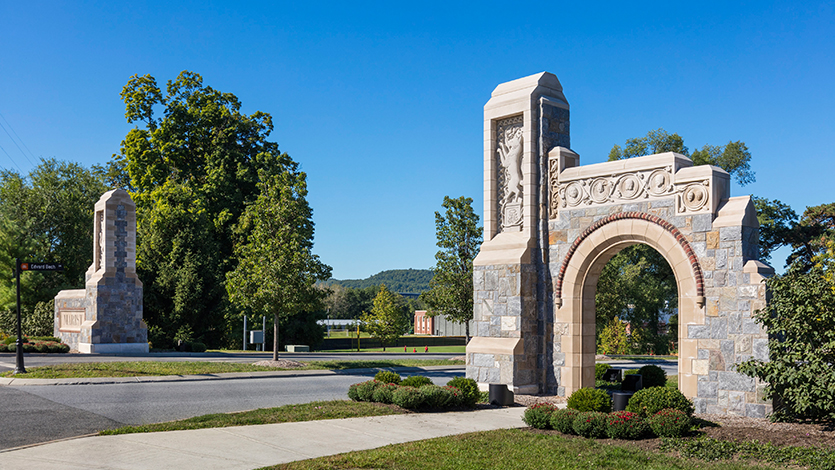
The South Gate is the most elaborate of Marist's three gates, and it serves as the main entrance for most visitors to campus. This gate is known for the arch through which pedestrians walk, and also for its distinctive stone carvings: the rampant fox and the medallions of important historical figures associated with the Hudson River Valley and Marist. The South Gate’s various carvings were done by Chris Pellettieri, an artist and stone carver best known for his work at the Cathedral of St. John the Divine in New York City.
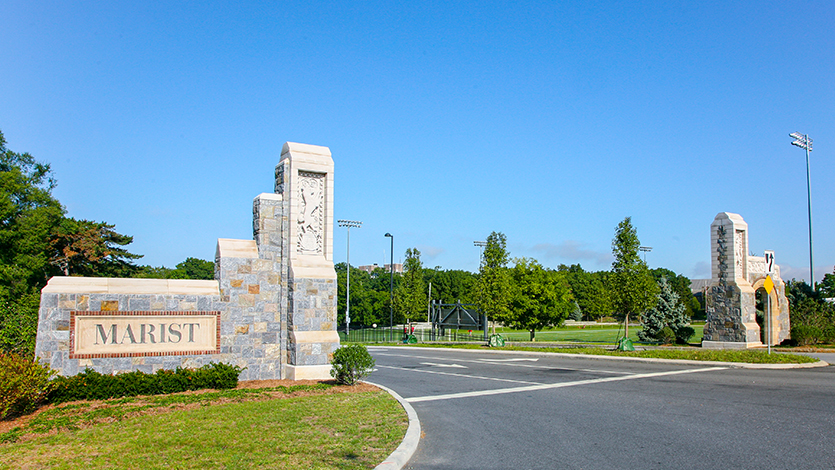
The Rampant Fox
The fox depicted on Marist’s South Gate acknowledges the long tradition of the fox as a heraldic symbol of wisdom. Heraldry is an intricate system of symbols and insignia (known as “charges”), which were created and passed down through generations for the purpose of identifying families. An ancient practice, heraldry came to prominence in Europe in the 12th century, during which time families displayed their emblems on shields, surcoats, and tabards worn over chain mail in battle. Heraldic “coats of arms” became so popular in the Middle Ages that, in 1483, Herald’s College was chartered to begin regulating the practice. The heraldic tradition survives today through the seals that can be found at many institutions of higher education.
Heraldic foxes can be found on several crests, including those of Lord Ilchester, Sir Watkin Williams Wynn, as well as the Fox, Colfox, and Ashworth families. Like other four-legged beasts, they are most commonly depicted in the rampant (rearing up) position, in profile, and with forepaws raised. They symbolize wisdom, specifically cunning, and wise defense.
The fox as a symbol of wisdom predates its popularity in the heraldic tradition of the Middle Ages by more than a millennium. Perhaps the earliest written reference to the fox as a symbol for wisdom comes from the Greek lyric poet Archilochus (c. 680 – 645 BCE). According to Archilochus, “the fox knows many things, while the hedgehog knows one big thing.” Cunning foxes can also be found throughout Western literature, including Aesop’s fables, Finnish mythology, and many other sources. The mascot of Marist’s athletic teams is, of course, the red fox, a species that is native to the Hudson River Valley.
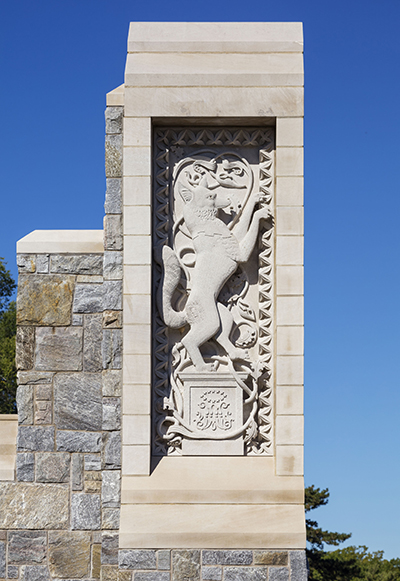
Historic Figures Associated with the Hudson River Valley and Marist
The medallions on the South Gate depict important figures from different historical eras who have influenced the growth and development of the Hudson River Valley and Marist. This region of New York has been designated by Congress as a National Heritage Area, and Marist is a part of this legacy. In fact, Marist's Hudson River Valley Institute serves as the academic arm of the Hudson River Valley National Heritage Area, charged with capturing the area’s rich history and passing it on to future generations.
The images represented on Marist’s South Gate were carefully chosen to represent people associated with Marist and/or the historic region it calls home. Following are descriptions of the ten medallions.
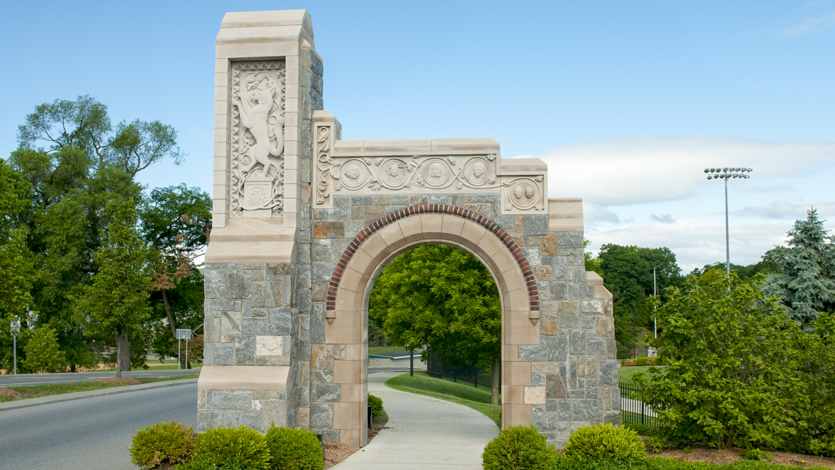
St. Ann
St. Ann was the original name of the Marist Brothers’ property in Poughkeepsie. In Christian tradition, St. Ann is the mother of the Virgin Mary, to whom the Brothers have a special devotion. In 1905, the Brothers purchased land and a house from Thomas MacPherson on the site of the current campus, naming the building and property St. Ann’s Hermitage in recognition of this tie.
Edvard Bech
In 1908, the Marist Brothers purchased the Edvard Bech estate, expanding their original holdings. Bech was a Danish-born industrialist who started the Tuckerman and Bech Iron Company in Poughkeepsie. He was also a partner in the Cunard Steamship Company. He hired German architect Detlef Lienau to design his estate, but only the carriage house, barn, and gatehouse had been completed when Bech died in 1873. These three service buildings are today known as Greystone, St. Peter’s, and the Kieran Gate House, and were listed on the National Register of Historic Places in 1991. Greystone has served as the location for the President’s Office for Marist for many decades.
St. Marcellin Champagnat
St. Marcellin Champagnat was a 19th century French priest who founded the Marist Brothers, a Catholic religious order dedicated to educating young people. His followers eventually spread to the United States and around the world. One group of Brothers settled on the banks of the Hudson River in Poughkeepsie in 1905 and established a seminary for future Marist Brothers. That training school evolved into present-day Marist.
Frederic Church
Frederic Church was an American landscape painter who, along with Thomas Cole, was a central figure in the Hudson River School, a 19th century American art movement influenced by Romanticism and the first identifiable school of art in the United States. The Hudson River School painters captured the dramatic beauty of this area’s landscapes, and their images are greatly valued to this day. Marist students, faculty, and staff enjoy the same breathtaking views of the Hudson River that inspired Church, Cole, and other artists.
Henry Hudson
Henry Hudson was an English explorer and navigator who explored the river that now bears his name. Famously called “America’s First River” by journalist Bill Moyers, the Hudson played a central role in America’s development. In September 1609, Hudson sailed by what is now the Marist campus, and was intimately involved in the Quadricentennial celebration of Hudson’s historic expedition. Marist has become closely identified with the Hudson River, and it is committed to protecting its scenic beauty. In fact, Marist is home to a high-tech environmental monitoring station that tracks the river’s health; the station was built at Marist in partnership with the U.S. Geological Survey, the New York State Department of Conservation, and the Cary Institute for Ecosystem Studies.
Daniel Nimham
The last Chief of the Wappinger tribe, Daniel Nimham died fighting for the American side during the Revolutionary War. This medallion pays tribute to Nimham and all of the Hudson River Valley’s indigenous inhabitants. Indeed, the name Poughkeepsie derives from a word in the Wappinger language and means “the reed-covered lodge by the little water place.”
Franklin and Eleanor Roosevelt
The 32nd U.S. President and his wife were global figures who helped to shape the 20th century and who made their home in nearby Hyde Park. During his time in the White House, President Roosevelt famously declared, “All that is within me cries out to go back to my home on the Hudson River.” Today, the Roosevelts’ legacy lives on through the Franklin D. Roosevelt Presidential Library and Museum and the Eleanor Roosevelt Center at Val-Kill. Marist is proud to be affiliated with the Roosevelt Presidential Library, one of only six colleges or universities in the nation to have such an affiliation.
Sojourner Truth
The 19th century abolitionist and women’s rights activist was born in Esopus, Ulster County and spent much of her early life in the Hudson River Valley. For the first nine years of her life, she was owned by a Dutch family and spoke only the Dutch language. After gaining her freedom, she would go on to become one of the nation’s leading voices against slavery and in favor of equal rights for women.
George Washington
Our first president has a unique connection to the Hudson River Valley because of the region’s central role in America’s War of Independence. During the Revolution, General Washington spent about one-third of his time in this area; in fact, his headquarters for the last 16 ½ months of the war was located in Newburgh. It has been said that the Revolution started in Boston, ended at Yorktown, but was fought in the Hudson River Valley.
John Flack Winslow
John Flack Winslow was a leading 19th century industrialist who helped to finance the construction of the USS Monitor, which made history in 1862 by defeating the ironclad CSS Virginia (formerly the USS Merrimack) at Hampton Roads, Virginia during the Civil War. Winslow is generally believed to have convinced President Abraham Lincoln to build the Monitor. Winslow’s estate was located on what is now the northern part of the Marist campus.
Marist’s Central Gate and Gatehouse
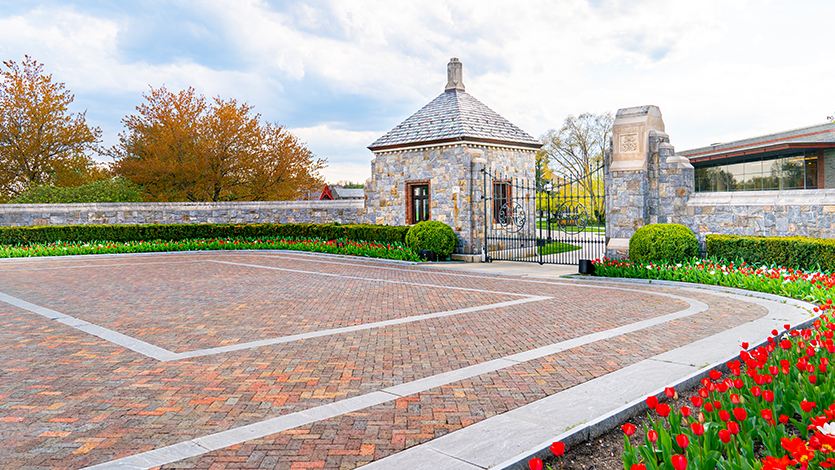
The Central Gate and Gatehouse stand at the midpoint of the west campus, providing both a functional and a ceremonial entrance to Marist. This entrance is not normally open to traffic, with the exception of emergency vehicles, but the gate is opened for certain special occasions such as Commencement. The distinctive gatehouse pays homage to the historic cottages of the Bech estate and is of similar size. Constructed with the same granite and limestone as the South Gate, as well as a slate roof, this structure is designed to remain an iconic landmark for generations. The handsome bronze gates are embossed with a script ‘M,’ a symbol of the Marist Brothers who founded Marist and an element of Marist's seal. The Central Gate is surrounded by an attractively landscaped plaza that frames it beautifully.
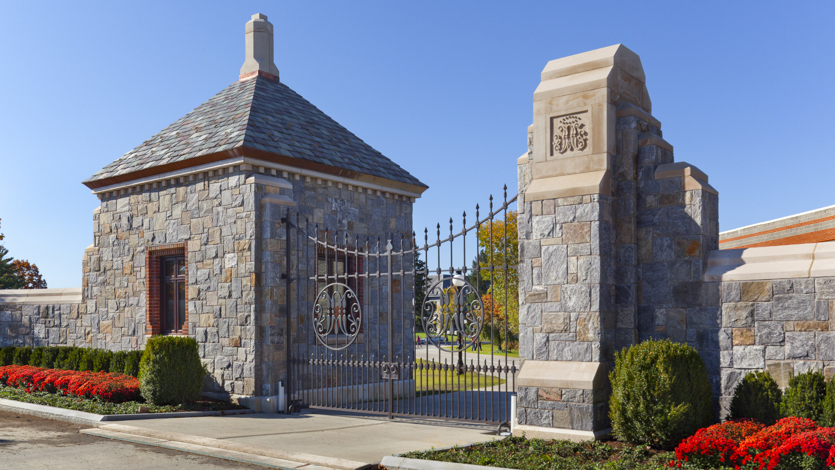
|
|
Marist’s North Gate
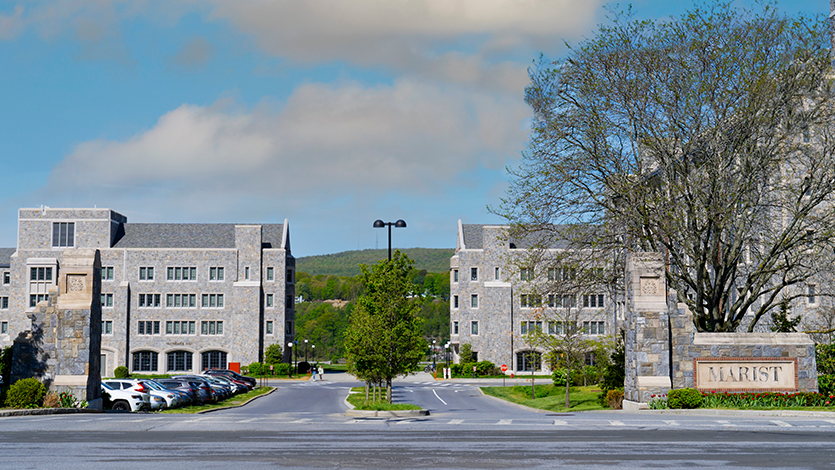
Bracketing the Marist campus is the North Gate, a landmark that defines the north end of Marist campus and serves as the entrance for visitors coming from points north. Smaller in scale than its counterparts to the south, it is nonetheless equally striking. Marist's North Gate uses the same materials as the other gates and is adorned with the same limestone monogram. The large ‘M’ on the North Gate is the traditional symbol of the Marist Brothers. The 12 stars, which appear about the ‘M,’ are a scriptural symbol of the Virgin Mary, to whom the Marist Brothers are devoted. The order originated with Marcellin Champagnat in France in 1817. In recognition of this heritage, a variation of this ‘M’ can also be found on the Marist seal.


|
|
Special thanks go out to the following people for their work documenting the history of Marist’s iconic campus gates: John Ansley, Director, Archives and Special Collections; Justin Butwell, Director of Physical Plant; Elisabeth Tavarez, Special Assistant to the President; and Thom Wermuth, Vice President for Academic Affairs.
Photo Credit: First South Gate image, Rampant Fox image, Central Gatehouse and Central Gate images: Peter Aaron/Otto for Robert A.M. Stern Architects
